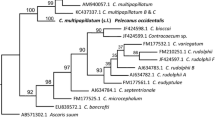Abstract
Many authors are of the opinion that intracellular freezing causes death of cells. Observations on organisms tolerating intracellular freezing have been regarded not convincing or exceptional. In this investigation, experiments dealing with polyps of the cnidarians Laomedea flexuosa and L. loveni are described. A special experimental procedure made it possible to induce, selectively, extra- and intracellular freezing or extra-cellular freezing alone. Ice crystals could not be observed directly, but darkening of the test individuals is indicative of ice formation in the cell; this darkening (flashing or black-out) always follows ice formation in the surroundings. Intracellular ice formation is endured for a short period of time (Fig. 1). Small differences in freezing temperature exert great influence on survival rates (Fig. 2). These depend also on the duration of exposure to freezing conditions. Freezing resistance is lower after intracellular ice formation; the difference, however, appears to involve quantitative rather than qualitative aspects, although intracellular ice formation could possible destroy protoplasmic structures.
Zusammenfassung
-
1.
Intrazelluläre Eisbildung ist bei Polypen der Cnidarier Laomedea flexuosa und L. loveni nicht direkt zu erkennen. Man kann aber von einem Dunkelwerden der Tiere auf Eiskristalle in den Zellen schließen, weil diese Erscheinung unabhängig von der Temperatur nur bei Vorhandensein von Impfkristallen auftritt.
-
2.
Durch eine spezielle Versuchsausführung konnten wir wahlweise extra- und intra- oder nur extra-zelluläres Gefrieren auslösen. Intrazelluläre Eisbildung muß nicht unbedingt zum Tod der Tiere führen. Es kommt wie bei der extrazellulären Eisbildung auf die Dauer der Einwirkung an (Abb. 1 und 2).
-
3.
Intrazelluläre Eisbildung wirkt zwar stärker schädigend als nur extrazelluläre, doch scheint nur ein quantitativer Unterschied zu bestehen und kein qualitativer. Wahrscheinlich werden in beiden Fällen gleiche Schäden verursacht, bei der intrazellulären Eisbildung jedoch verstärkt.
-
4.
Kleine Unterschiede der Gefriertemperaturen haben auf die Überlebensrate einen großen Einfluß.
Similar content being viewed by others
Zitierte Literatur
Asahina, E. (Ed.): Cellular injury and resistance in freezing organisms. Int. Conf. low Temp. Sci. 2, (Hokkaido) 1967.
Levine, N. D. and F. L. Andersen: Frozen storage of Tritrichomonas foetus for 5.6 years. J. Protozool. 13, 199–202 (1966).
Luyet, B. J. and P. M. Gehenio: Life and death at low temperatures. Biodynamica 3, 1–341 (1940).
Meryman, H. T. (Ed.): Cryobiology, 775 pp. London: Academic Press 1966.
Salt, R. W.: A comparison of injury and survival of larvae of Ceptus cinctus Nort. after intracellular and extracellular freezing. Can. J. Zool. 39, 349–357 (1961)
—: Intracellular freezing in insects. Nature, Lond. 193, 1207–1208 (1962)
Sherman, J. K.: Survival of higher animal cells after the formation and dissolution of intracellular ice. Anat. Rec. 144, 171–190 (1962
Sømme, L.: Seasonal changes in the freezing-tolerance of some intertidal animals. Nytt Mag. Zool. 13, 52–55 (1966).
Troshin A. S. (Ed.): The cell and environmental temperature, 462 pp. Transl. from Russian. Engl. ed. by C. L. Prosser. Oxford: Pergamon Press 1967.
Vogel, W.: Über die Hitze-und Kälteresistenz von Zoothamnium hiketes Precht (Ciliata, Peritricha). Z. wiss. Zool. 173, 344–378 (1966).
Wang, G. T. and W. C. Marquardt: Survival of Tetrahymena pyrifomis and Paramaecium aurelia following freezing. J. Protozool. 13, 123–128 (1966).
Author information
Authors and Affiliations
Additional information
Communicated by O. Kinne, Hamburg
Rights and permissions
About this article
Cite this article
Jankowsky, H.D., Laudien, H. & Precht, H. Ist eine intrazelluläre Eisbildung bei Tieren tödlich? Versuche mit Polypen der Gattung Laomedea . Marine Biology 3, 73–77 (1969). https://doi.org/10.1007/BF00355594
Accepted:
Issue Date:
DOI: https://doi.org/10.1007/BF00355594




